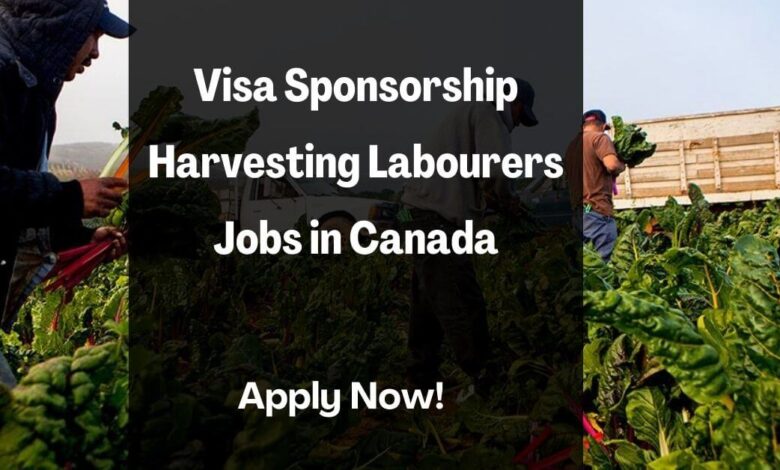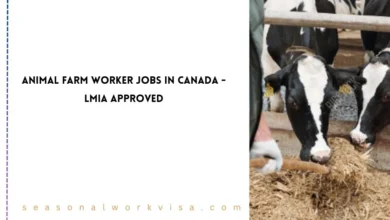Visa Sponsorship Harvesting Labourers Jobs in Canada 2025

The typical salary range for harvest laborers in Canada is 15 to 20 CAD per hour, making it a stable income option for workers. The agricultural zone of Canada is the backbone of its economy, ensuring food security for the nation while offering employment to thousands of individuals. As the industry continues to expand, the demand for harvest laborers is expected to grow even further.
There are numerous opportunities for foreign workers to secure employment through visa sponsorship programs, opening doors for a reliable livelihood and career growth. This guide provides comprehensive information about the qualifications, benefits, duties, compensation, job opportunities, and service delivery methods for those interested in pursuing agricultural jobs in Canada.
Details of Harvesting Labourers Job in Canada:
- Title: Visa Sponsorship Harvesting Labourers Jobs in Canada
- Position: Harvesting Labourers
- Location: Various locations across Canada
- Employment Type: Full-time, Seasonal
- Visa Sponsorship: Available through the Temporary Foreign Worker Program (TFWP) or the Seasonal Agricultural Worker Program (SAWP)
Job Requirements:
In Canada, formal education is no longer a prerequisite for harvest worker positions; however, employers are seeking specific talents and attributes.
- Physical Fitness: Harvesting is a physically demanding task that necessitates the ability to work extended hours in a variety of climates, as well as electricity and stamina.
- Experience: Although it is not currently mandatory, prior experience in agriculture or comparable in-depth work is advantageous.
- Teamwork Skills: The capacity to function effectively in a crew environment is essential, as farm work frequently necessitates collaboration.
- Fundamental comprehension of agricultural operations: It is advantageous to comprehend the fundamentals of vegetation cultivation, preservation, and harvests.
- Language proficiency: A fundamental understanding of French or English is essential for comprehending safety instructions and engaging in conversation.
- Adaptability: A propensity to learn and the ability to adapt to unique commitments are highly regarded qualities.
Duties of Harvesting Labourers Jobs:
- Employment Opportunities: Canada’s agricultural sector is robust, resulting in a plethora of employment openings, particularly during the peak harvest seasons. This is especially advantageous for those searching for temporary or seasonal employment.
- Competitive Wages: Numerous harvesting positions provide competitive pay rates, and certain positions may include incentives or overtime pay, particularly during peak periods.
- Skill Development: Harvesting positions provide individuals with the opportunity to acquire practical skills in a variety of agricultural disciplines, including crop management, equipment operation, and collaboration.
- Physical Activity: Harvesting occupations frequently involve physical labor, which can be a healthy method of maintaining physical fitness while earning a living.
- Cultural Exchange: The variety of harvesting occupations in Canada attracts a diverse workforce, which offers opportunities for cultural exchange and networking with individuals from a variety of social backgrounds.
- Experience for Future Employment: Individuals who are interested in careers in agriculture, environmental science, or related disciplines may find agricultural work to be advantageous.
- Rural Living Experience: The Canadian countryside and lifestyle are accessible through numerous harvesting jobs that are situated in rural locations.
- Flexible Hours: The work hours may be flexible, depending on the employer and the specific function, which can facilitate the balancing of other commitments for employees.
- Housing Accessibility: Certain employers offer accommodations to their employees, which can reduce the anxiety associated with locating housing in rural regions.
- Networking Opportunities: Employment in harvesting can result in connections within the agricultural sector, which may be advantageous for future employment opportunities or career advancement.
Check Also: Labourer Paving Operations Jobs in Canada
Benefits of Job:
1. Visa Sponsorship Support
- Employers support the Seasonal Agricultural Worker Program (SAWP) or Temporary Foreign Worker Program (TFWP).
- Assistance in processing labor market impact assessments, or LMIAs
- Per Canadian immigration regulations, authorization to enter and work
2. Competitive Salary
- The average hourly wage is between $15.50 and $18.00 CAD.
- Opportunities for overtime at busy times
- Pay is frequently based on provincial minimum wage regulations.
3. Free or Subsidized Accommodation
- Usually, employers offer free housing or a small cost.
- Housing complies with safety and health regulations.
4. Free Meals or Meal Allowance
- Some firms provide their employees with free or heavily discounted meals while they are working.
5. Travel Assistance
- Under some programs (particularly SAWP), you may be eligible for free or compensated airfare from your home country to Canada.
- At the conclusion of the contract, a return ticket can also be offered.
6. Seasonal and Renewable Work Contracts
- Seasonal employment opportunities (up to 8 months)
- High likelihood of contract renewal for employees that perform well
- Many co
7. No Advanced Education Required
- Ideal for people with little or no formal schooling
- Very little experience is needed; on-the-job training is offered.
8. Health Coverage
- Availability of employer-sponsored health insurance or provincial health insurance (varies by province/employer)
Salary:
The compensation for harvesting employment in Canada is contingent upon factors such as the type of crop, region, and employer. Have in common:
- Hourly Wage: The typical range is 15 to 20 CAD per hour.
Types of Harvesting Labourers Jobs in Canada:
The agricultural landscape of Canada is diverse, and there are numerous varieties of harvest worker jobs. The following are ten prevalent types:
- Fruit Picker: Collect the halt result in conjunction with apples, berries, and grapes.
- Vegetable Picker: The act of selecting greens, which include cucumbers, tomatoes, and peppers.
- Grain Harvester: Perform duties on plantations that cultivate wheat, barley, and other grains.
- Vineyard Worker: A professional who specializes in the harvesting of fruits for the production of wine.
- Greenhouse Worker: Perform tasks in a controlled environment, including the cultivation and harvesting of flowers.
- Orchard Worker: Concentrated on the cultivation of tree plants in conjunction with apples, pears, and cherries.
- floral Harvester: The process of gathering plants for the commercial floral industry.
- Root Crop Harvester: Harvest beets, carrots, and potatoes in addition to vegetation.
- Nut Picker: Collect nuts, as well as almonds, walnuts, and pecans.
- Cannabis Harvester: Harvest hashish flowers from certified plantations.
Application Process:
- Investigate employment prospects: Begin by conducting an online search for employment opportunities on agricultural websites, activity forums, and agency careers sites in Canada.
- Draft your curriculum vitae: Customize your resume to emphasize pertinent qualifications, aptitudes, and interests. Incorporate any prior experience with agricultural painting, manual labor, and language skills.
- Submit an employment application: Submit your application through the organization’s designated method, which may involve online forms, emails, or activity portals.
- Employment opportunity: Provide and assess phrases and scenarios, including salary, painting hours, lodging preparations, and visa sponsorship information, following the receipt of the process. Obtain an offer if the entire property is exceptional.
- Visa Application: Track your employment visa once the process is complete. The organization consistently assists with the visa process by submitting critical documentation and managing the process.
- Orientation and Training: Upon your arrival, you will have the opportunity to participate in an orientation session and training to rapidly become acquainted with the farm’s operations, safety protocols, and activities.
- Get to work: Commence your new role as a harvest worker and make a meaningful contribution to the thriving agricultural sector of Canada.
Conclusion:
For foreign workers looking for seasonal work with visa sponsorship, Canada’s thriving agricultural sector offers a great option. Harvesting laborer positions are perfect for anyone who wants to work physically, travel, and support food security since they offer competitive pay, low entrance requirements, and the opportunity to experience rural Canadian living. Applying through well-known programs such as SAWP and TFWP gives applicants access to travel aid, legal work permits, and even possible contract extensions. Explore your options, get your application ready, and embrace this vital and ever-evolving industry to start your path to a fulfilling agricultural career in Canada.
Frequently Asked Questions:
What is a harvesting Labourer?
Harvesting laborers and related workers assist other farm workers in planting, harvesting, sorting, and packing crops. They participate in soil preparation, irrigation, crop planting, spraying, and thinning. Fruit, vegetable, and specialty crop farms employ them.
Is harvesting an occupation?
Harvesting workers are part of the broader occupational groups 85101, 85102, and 85120 (harvesting, aquaculture, and forestry laborers).
How much do farm laborers make in Canada?
How much does a farm worker make in Canada? The average farm worker salary in Canada is $29,889 per year or $15.33 per hour. Entry-level positions start at $27,300 per year, while most experienced workers make up to $40,950 per year.




